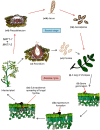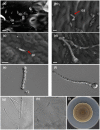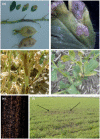Ascochyta rabiei: A threat to global chickpea production
- PMID: 35778851
- PMCID: PMC9366070
- DOI: 10.1111/mpp.13235
Ascochyta rabiei: A threat to global chickpea production
Abstract
The necrotrophic fungus Ascochyta rabiei causes Ascochyta blight (AB) disease in chickpea. A. rabiei infects all aerial parts of the plant, which results in severe yield loss. At present, AB disease occurs in most chickpea-growing countries. Globally increased incidences of A. rabiei infection and the emergence of new aggressive isolates directed the interest of researchers toward understanding the evolution of pathogenic determinants in this fungus. In this review, we summarize the molecular and genetic studies of the pathogen along with approaches that are helping in combating the disease. Possible areas of future research are also suggested.
Taxonomy: kingdom Mycota, phylum Ascomycota, class Dothideomycetes, subclass Coelomycetes, order Pleosporales, family Didymellaceae, genus Ascochyta, species rabiei.
Primary host: A. rabiei survives primarily on Cicer species.
Disease symptoms: A. rabiei infects aboveground parts of the plant including leaves, petioles, stems, pods, and seeds. The disease symptoms first appear as watersoaked lesions on the leaves and stems, which turn brown or dark brown. Early symptoms include small circular necrotic lesions visible on the leaves and oval brown lesions on the stem. At later stages of infection, the lesions may girdle the stem and the region above the girdle falls off. The disease severity increases at the reproductive stage and rounded lesions with concentric rings, due to asexual structures called pycnidia, appear on leaves, stems, and pods. The infected pod becomes blighted and often results in shrivelled and infected seeds.
Disease management strategies: Crop failures may be avoided by judicious practices of integrated disease management based on the use of resistant or tolerant cultivars and growing chickpea in areas where conditions are least favourable for AB disease development. Use of healthy seeds free of A. rabiei, seed treatments with fungicides, and proper destruction of diseased stubbles can also reduce the fungal inoculum load. Crop rotation with nonhost crops is critical for controlling the disease. Planting moderately resistant cultivars and prudent application of fungicides is also a way to combat AB disease. However, the scarcity of AB-resistant accessions and the continuous evolution of the pathogen challenges the disease management process.
Useful websites: https://www.ndsu.edu/pubweb/pulse-info/resourcespdf/Ascochyta%20blight%20of%20chickpea.pdf https://saskpulse.com/files/newsletters/180531_ascochyta_in_chickpeas-compressed.pdf http://www.pulseaus.com.au/growing-pulses/bmp/chickpea/ascochyta-blight http://agriculture.vic.gov.au/agriculture/pests-diseases-and-weeds/plant-diseases/grains-pulses-and-cereals/ascochyta-blight-of-chickpea http://www.croppro.com.au/crop_disease_manual/ch05s02.php https://www.northernpulse.com/uploads/resources/722/handout-chickpeaascochyta-nov13-2011.pdf http://oar.icrisat.org/184/1/24_2010_IB_no_82_Host_Plant https://www.crop.bayer.com.au/find-crop-solutions/by-pest/diseases/ascochyta-blight.
Keywords: Ascomycota; fungicide resistance; host resistance; necrotrophic fungus.
© 2022 The Authors. Molecular Plant Pathology published by British Society for Plant Pathology and John Wiley & Sons Ltd.
Figures



References
-
- Akamatsu, H.O. , Chilvers, M.I. , Kaiser, W.J. & Peever, T.L. (2012) Karyotype polymorphism and chromosomal rearrangement in populations of the phytopathogenic fungus, Ascochyta rabiei . Fungal Biology, 116, 1119–1133. - PubMed
-
- Akem, C. (1999) Ascochyta blight of chickpea: present status and future priorities. International Journal of Pest Management, 45, 131–137.
-
- Ali, H. , Alam, S.S. , Attanayake, R.N. , Rahman, M. & Chen, W. (2012) Population structure and mating type distribution of the chickpea blight pathogen Ascochyta rabiei from Pakistan and the United States. Journal of Plant Pathology, 94, 99–108.
-
- Anbessa, Y. , Taran, B. , Warkentin, T.D. , Tullu, A. & Vandenberg, A. (2009) Genetic analyses and conservation of QTL for ascochyta blight resistance in chickpea (Cicer arietinum L.). Theoretical and Applied Genetics, 119, 757–765. - PubMed
-
- Armstrong, C.L. , Chongo, G. , Gossen, B.D. & Duczek, L.J. (2001) Mating type distribution and incidence of the teleomorph of Ascochyta rabiei (Didymella rabiei) in Canada. Canadian Journal of Plant Pathology, 23, 110–113.
Publication types
MeSH terms
Substances
Supplementary concepts
LinkOut - more resources
Full Text Sources

